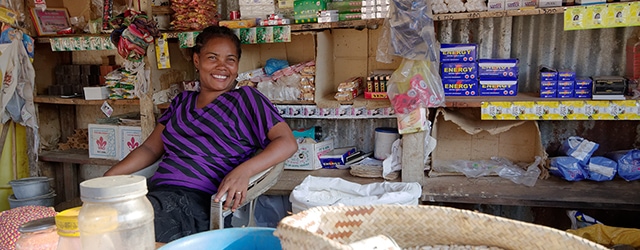Once hailed as a game-changer for the impoverished, microlenders are falling behind in the digital race while online lenders and commercial banks poach their turf.

Back in 2005, UN Secretary General Kofi Annan called microfinance institutions (MFIs) “an idea whose time has come.” A year later, Muhammad Yunus, founder of Bangladesh’s Grameen Bank and arguably the father of microfinance, received the Nobel Peace Prize for championing the creation of “economic and social development from below.”
Fashioned as the ultimate solution to financial inclusion, microfinance was widely expected to explode, boosting developing economies and shaking up the rigid world of bank lending. MFIs entered the financial space by carving out a virgin niche, providing credit access to millions of unbanked people shunned by mainstream commercial institutions.
A decade and a half later, microfinance appears to be on its death bed, as innovations—particularly digital and mobile lending—renders MFIs obsolete.
Despite some attempts to embrace new technologies and even expand into deposit-taking, MFIs have been mightily disrupted by digitalization. Today, commercial banks are eating into their market while policymakers move in with regulations, spurred by concerns that some MFIs have placed their clients in debt peonage by bombarding them with loans. Meanwhile, some erstwhile clients are moving their business to banks that can address their needs for much bigger loans.
The Covid-19-induced economic crisis is aggravating the industry’s plight. Unlike commercial banks, which are required to have strong shock absorbers, many MFIs are reporting portfolio quality deterioration, liquidity constraints, rising defaults, reduced lending and forced loans restructuring.
According to a survey by the Consultative Group to Assist the Poor (CGAP), which focuses on providing timely and relevant data on the unfolding of the crisis, the microfinance sector is experiencing “tremendous strain.” Covid -19 is forcing financial institutions of all sorts and sizes to execute a quick transformation to digital platforms—a serious challenge for many MFIs, given their relatively modest asset base.
“Microfinance is an incredibly heterogeneous industry,” says Greta Bull, chief executive of CGAP and a World Bank Group director. While some will thrive, others will struggle. “I would argue that those that adapt will be in the best position to survive the digital challenge.”
“Digitalization Is Key”
Back when Yunus was accepting his Nobel Prize, by contrast, MFIs seemed to have all the right tools. Global institutions were willing to provide funds for on-lending. Microlenders weren’t bogged down by prudential guidelines and regulations. They were devoid of the complexities of mainstream banking, including strategically located brick-and-mortar locations, legacy technology and skills. And they were structured to reach poor people, particularly rural women and youth, with short-term microloans as small as $20.
More critically, they had a huge market at their disposal. In 2005, 2.5 billion adults, just over half the world’s adult population, didn’t use formal financial services to save or borrow. A majority—2.2 billion, according to the Financial Access Initiative—were located in Africa, Asia, Latin America and the Middle East.
The apparent winning card for MFIs, however, was their use of social collateral as opposed to the physical kind, reflecting the fact that young people and women rarely had land or other assets to put up. “The use of social collateral opens up opportunities for financial inclusion,” says Bart van Eyk, director of Investments at Oikocredit.
The combination of technological transformation, incursions by commercial banks, heightened regulation and now Covid-19 stunted microlenders’ growth. From 2000 to 2010, according to the Microfinance Information Exchange (MIX) Market, an initiative of the World Bank, MFIs recorded an average annual growth rate of 20%; since 2012, growth has averaged only 7%.
As of 2018, the sector had about 140 million customers globally, a marginal increase from 112.5 million in 2014; while its combined loan portfolio stood at $124 billion, up from $87.3 billion in 2014. Today, 80% of clients are women and 65% of clients live in rural areas.
The stagnation of microfinance is evident in countries like Nigeria and Kenya, which only a decade ago appeared to have among the best potential for it. Central Bank of Nigeria data show that in 2018 the industry consisted of 885 microfinance banks, down from 1,008 a year earlier. During that year, total assets and liabilities rose only modestly, to $1 billion from $912.2 million.
Other key indicators were blinking red. Average portfolio-at-risk increased to 23.1% from 21.2%, indicating a further deterioration in the quality of risk assets. Industry average return on assets declined to 1.2% from 3.9% while return on equity increased to 16.46% compared with 7.6% in 2017.
Data from the Central Bank of Kenya show that in 2018, total assets of the country’s 13 deposit-taking MFIs stood at $183.3 million, a paltry 4.7% higher than the previous year’s $175.3 million. In context, Kenyan MFIs’ total assets in 2018 were equivalent to those of a tier-three Kenyan commercial bank.
The explosion of mobile and online lending has been the biggest blow to microlenders. MFIs have a tendency to charge high interest rates, in part because they primarily on-lend cash borrows from development finance institutions and in part because they deal mainly with high-risk customers.
“The cost to borrowers will inevitably reflect the risk of lending,” says Bull. She adds that because many borrowers don’t have credit histories, that risk is assumed to be relatively high and is priced accordingly. That being the case, the majority of clients needing quick credit have moved to digital lenders offering lower rates, while commercial banks are taking over those that have managed to build credit histories. Commercial banks are also targeting MFIs for acquisition.
Proponents of MFIs point out that the industry still has 1.7 billion clients, a global population of adults with inadequate access to formal financial services and lacking an account with either a larger financial institution or a mobile money provider.
To preserve and grow this audience, Laura Foschi, executive director of Luxembourg-based ADA Microfinance, says embracing new technologies and developing more customer-centric products will be critical. “Digitalization is key,” she notes, saying it could offer a chance for MFIs to reimagine their business models. While most MFI clients are women and rural-based and might not have access to the internet to carry out internet banking, a small but growing number are using smartphones. Finding a method to harness the devices to provide new services to them could keep some microlenders in business.



